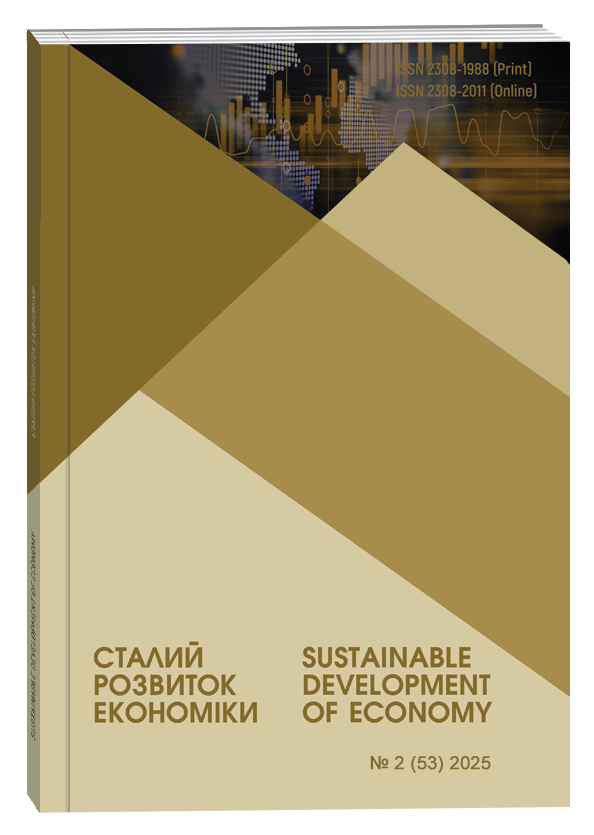DIGITAL HYGIENE AND INFORMATION SECURITY IN SCOPE OF DIGITAL EDUCATIONAL ACTIVITIES
Abstract
This publication outlines the main theoretical and methodological foundations of digital hygiene and information security for both teachers and students in the field of digital educational activities. In today's digital transformation of education, every participant in the educational process must be confident in the security of the platforms and methods of distance learning used by higher education institutions. Given the trend towards an increase in cyberattacks on the education sector, information protection is a critically important aspect of university activities. Students are the basis of the existence of teaching activities in higher education institutions, because without them the educational process is impossible, however, due to the significantly larger number of students compared to teachers, they are the most vulnerable to attacks and often become tools for the distribution of malicious software. The main targets of attackers remain teachers and administrative staff of higher education institutions, since it is they who have access to important data, educational process management systems, financial resources and scientific developments. Particular attention is paid to the issue of the availability of effective methods and means of ensuring digital hygiene and information security for both distance learning platforms and teaching and research activities. Failures or suspension of activities in this area can cause both significant financial and reputational losses for a higher education institution. Loss or compromise of scientific data can significantly affect the competitiveness of a university both at the national and international levels. In the context of modern digital threats, the implementation of advanced technologies, including artificial intelligence, to ensure security and automate threat monitoring is important. The use of machine learning algorithms allows you to detect anomalous activity in educational systems, prevent potential attacks and respond promptly to incidents. The necessary steps are outlined for further in-depth study of this topic, including the development of new protection methods, systematic training of students and teachers on safe behavior in the digital environment, and expansion of the regulatory framework for effective information security management in the education sector.
References
Burov O., Butnik-Siverskyi O., Orliuk O., Horska K. Cybersecurity and innovative digital educational environment. Information Technologies and Learning Tools. 2020. № 80. С. 414–430. DOI: https://doi.org/10.33407/itlt.v80i6.4159.
Yousif Yaseen, K. A. Digital Education: The Cybersecurity Challenges in the Online Classroom (2019-2020). Asian Journal of Computer Science and Technology, 2022, Vol. 11(2), Pp. 33–38. DOI: https://doi.org/10.51983/ajcst-2022.11.2.3450
Check Point Software Technologies. Cyber Security Report 2024. 2024, Vol1, p.50. URL: https://www.checkpoint.com/resources/report-3854/report--cyber-security-report-2024 (дата звернення: 25.03.2025).
European Union Agency for Cybersecurity (ENISA). ENISA Threat Landscape 2023. 2023, pp 70-83. DOI: https://doi.org/10.2824/782573
Palo Alto Networks. Prisma Unit 42 Cloud Threat Research. 2023, Vol 7, pp. 4-5. URL: https://www.paloaltonetworks.com/prisma/unit42-cloud-threat-research (дата звернення: 20.03.2025).
CERT-UA. Government Computer Emergency Response Team of Ukraine. (n.d.). URL: https://cert.gov.ua/about-us (дата звернення: 20.03.2025).
WatchGuard. Cyberattacks on the education sector increased by 258% last academic year. 2024. URL: https://www.watchguard.com/wgrd-news/blog/cyberattacks-education-sector-258-last-academic-year (дата звернення: 16.03.2025).
StateScoop. Ransomware attacks on the education sector declined in early 2024. 2024. URL: https://statescoop.com/ransomware-education-sector-decline-2024/ (дата звернення: 15.03.2025).
Bank of America. Cyber Attack Protection for Universities. 2024. URL: https://business.bofa.com/en-us/content/cyber-attack-protection-for-universities.html (дата звернення: 13.03.2025).
UpGuard. Top Cybersecurity Problems for Universities and Colleges. 2025. URL: https://www.upguard.com/blog/top-cybersecurity-problems-for-universities-colleges (дата звернення: 16.03.2025).
Wired. Meet the hired guns who make sure school cyberattacks stay hidden. 2025. URL: https://www.wired.com/story/meet-the-hired-guns-who-make-sure-school-cyberattacks-stay-hidden/ (дата звернення: 16.03.2025).
ThreatDown. 2024 State of Ransomware in Education: 92% Spike in K-12 Attacks. 2024. URL: https://www.threatdown.com/blog/2024-state-of-ransomware-in-education-92-spike-in-k-12-attacks/ (дата звернення: 18.03.2025).
BitLyft. The Impact of Cyber Attacks on Higher Education & How to Stay Protected. 2024. URL: https://www.bitlyft.com/resources/the-impact-of-cyber-attacks-on-higher-education-how-to-stay-protected (дата звернення: 22.03.2025).
Cybersecurity Dive. Ransomware attacks on schools surged in 2023. 2024. URL: https://www.cybersecuritydive.com/news/ransomware-schools-2023/725808/ (дата звернення: 21.03.2025).
Lemoie K., & Soares L. Connected impact: Unlocking education and workforce opportunity through blockchain. American Council on Education. 2020. URL: https://ipfs.io/ipfs/QmdEnhQcWHTY4ndotRs1YRpeTdjZGAyisHz8buqfYidkP2 (дата звернення: 03.04.2025).
IoT Security Foundation. Securing the Internet of Things. 2023. URL: https://iotsecurityfoundation.org/best-practice-guidelines/ (дата звернення: 01.03.2025).
Balakrishna C. and Charlton P. Using Game-based Learning Methods to Demystify Cyber Security Concepts for Adult Learners. Proceedings of the 16th European Conference on Games Based Learning. 2022. № 16. Pp. 73–80. DOI: https://doi.org/10.34190/ecgbl.16.1.804
Gjertsen E. G. B., Gjære E. A., Bartnes M. and Flores W. R. Gamification of information security awareness and training. ICISSP 2017 – Proceedings of the 3rd International Conference on Information Systems Security and Privacy. SciTePress. 2017. Pp. 59–70. DOI: https://doi.org/10.5220/0006128500590070
Muhammadu Sathik Raja Sathik Raja M. S. The Rise of AI-Driven Network Intrusion Detection Systems: Innovations, Challenges, and Future Directions. International Journal of AI, BigData, Computational and Management Studies. 2025. No. 6(1). Pp.1–9. DOI: https://doi.org/10.63282/3050-9416.IJAIBDCMS-V6I1P101
Hussain M. J. A. Survey Based on Behavior Analysis of Artificial Intelligence Using Machine Learning Process. 2024 4th International Conference on Sustainable Expert Systems (ICSES), Kaski, Nepal. 2024. Pp. 1694–1701. DOI: https://doi.org/10.1109/ICSES63445.2024.10763264
Шалений В., Зеленяк В., Фадеєв О. Впровадження стратегії розвитку персоналу в умовах діджиталізації. Modeling the Development of the Economic Systems. 2024. № 3. С. 137–144. DOI: https://doi.org/10.31891/mdes/2024-13-18
Duraz R., Espes D., Francq J., Vaton S. Using CVSS scores can make more informed and more adapted Intrusion Detection Systems. Journal of Universal Computer Science. 2024. No. 30(9). pp. 1244–1264. DOI: https://doi.org/10.3897/jucs.131659
Burov O., Butnik-Siverskyi O., Orliuk O., Horska K. (2020) Cybersecurity and innovative digital educational environment. Information Technologies and Learning Tools. No. 80. pp. 414–430. DOI: https://doi.org/10.33407/itlt.v80i6.4159
Yousif Yaseen, K. A. (2022) Digital Education: The Cybersecurity Challenges in the Online Classroom (2019-2020). Asian Journal of Computer Science and Technology, Vol.11(2), pp. 33–38. DOI: https://doi.org/10.51983/ajcst-2022.11.2.3450
Check Point Software Technologies. Cyber Security Report 2024. (2024). Vol1, p. 50. Available at: https://www.checkpoint.com/resources/report-3854/report--cyber-security-report-2024
European Union Agency for Cybersecurity (ENISA). ENISA Threat Landscape 2023. (2023). Pp 70-83. DOI: https://doi.org/10.2824/782573
Palo Alto Networks. Prisma Unit 42 Cloud Threat Research. (2023). Vol 7, pp. 4-5. Available at: https://www.paloaltonetworks.com/prisma/unit42-cloud-threat-research
CERT-UA. Government Computer Emergency Response Team of Ukraine. (n.d.). Available at: https://cert.gov.ua/about-us
WatchGuard. Cyberattacks on the education sector increased by 258% last academic year. 2024. Available at: https://www.watchguard.com/wgrd-news/blog/cyberattacks-education-sector-258-last-academic-year
StateScoop. Ransomware attacks on the education sector declined in early 2024. (2024). Available at: https://statescoop.com/ransomware-education-sector-decline-2024/
Bank of America. Cyber Attack Protection for Universities. (2024). Available at: https://business.bofa.com/en-us/content/cyber-attack-protection-for-universities.html
UpGuard. Top Cybersecurity Problems for Universities and Colleges. (2025). Available at: https://www.upguard.com/blog/top-cybersecurity-problems-for-universities-colleges
Wired. Meet the hired guns who make sure school cyberattacks stay hidden. (2025). Available at: https://www.wired.com/story/meet-the-hired-guns-who-make-sure-school-cyberattacks-stay-hidden/
ThreatDown. 2024 State of Ransomware in Education: 92% Spike in K-12 Attacks. (2024). Available at: https://www.threatdown.com/blog/2024-state-of-ransomware-in-education-92-spike-in-k-12-attacks/
BitLyft. The Impact of Cyber Attacks on Higher Education & How to Stay Protected. (2024). Available at: https://www.bitlyft.com/resources/the-impact-of-cyber-attacks-on-higher-education-how-to-stay-protected
Cybersecurity Dive. Ransomware attacks on schools surged in 2023. (2024). Available at: https://www.cybersecuritydive.com/news/ransomware-schools-2023/725808/
Lemoie K., & Soares L. (2020) Connected impact: Unlocking education and workforce opportunity through blockchain. American Council on Education. Available at: https://ipfs.io/ipfs/QmdEnhQcWHTY4ndotRs1YRpeTdjZGAyisHz8buqfYidkP2
IoT Security Foundation. Securing the Internet of Things. (2023). Available at: https://iotsecurityfoundation.org/best-practice-guidelines/
Balakrishna C. and Charlton P. (2022) Using Game-based Learning Methods to Demystify Cyber Security Concepts for Adult Learners. Proceedings of the 16th European Conference on Games Based Learning. No. 16. pp.73–80. DOI: https://doi.org/10.34190/ecgbl.16.1.804
Gjertsen E. G. B., Gjære E. A., Bartnes M. and Flores W. R. (2017) Gamification of information security awareness and training. ICISSP 2017 – Proceedings of the 3rd International Conference on Information Systems Security and Privacy. SciTePress. pp. 59–70. DOI: https://doi.org/10.5220/0006128500590070
Muhammadu Sathik Raja Sathik Raja M. S. (2025) The Rise of AI-Driven Network Intrusion Detection Systems: Innovations, Challenges, and Future Directions. International Journal of AI, BigData, Computational and Management Studies. No. 6(1). pp. 1–9. DOI: https://doi.org/10.63282/3050-9416.IJAIBDCMS-V6I1P101
Hussain M. J. A. (2024) Survey Based on Behavior Analysis of Artificial Intelligence Using Machine Learning Process. 2024 4th International Conference on Sustainable Expert Systems (ICSES), Kaski, Nepal. pp.1694–1701. DOI: https://doi.org/10.1109/ICSES63445.2024.10763264
Shalenyi V., Zeleniak V., & Fadeev O. (2024) Vprovadzhennia stratehii rozvytku personalu v umovakh didzhytalizatsii [Implementation of a staff development strategy in the context of digitalisation]. Modeling the Development of the Economic Systems. No. 3. pp. 137–144. DOI: https://doi.org/10.31891/mdes/2024-13-18 (in Ukrainian)
Duraz R., Espes D., Francq J., Vaton S. (2024) Using CVSS scores can make more informed and more adapted Intrusion Detection Systems. Journal of Universal Computer Science. no. 30(9). pp. 1244–1264. DOI: https://doi.org/10.3897/jucs.131659


